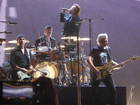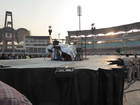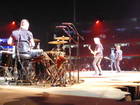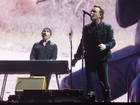If U2 play arenas, are they downsizing?
There is an interesting article in the Independent today that asks what's going on with U2. It starts out in a manner that many U2 fans may find antagonistic, but proceeds on to some worthwhile reflections about the tour, U2's place in the global music scene and live music market, and their fears of losing fans or becoming a nostalgia act. I bring up this one not because I agree or disagree with it (I think some parts are thoughtful and others problematic). Instead, I bring it up because it gives me an opportune moment to address an underappreciated side of U2's touring history at a time when fans are wondering what the next tour will involve and while I am in the midst of making my tour song predictions.
The Independent article begins with a claim that U2 "won't be taking in their traditional stadium stomping grounds" on the next tour and will "step down to smaller venues ... This is quite downsizing for an outfit who have always placed great store in being as big as possible." Such a perspective is not unique to this article. Mention stadium rock and U2 are often given as the definitive example of a stadium rock band - or, to their detractors, a lumbering old stadium dinosaur. U2's live releases tend to bolster the impression of the band as outdoor showmen. Zoo TV Sydney, Popmart Mexico City, Slane, U2 3D, and the Rose Bowl are all massive outdoor affairs performed in front of vast audiences. Rattle and Hum is cut from a number of shows, both indoor and outdoor. Bonus footage from Milan 2005 that came with U2:18 and the Paris 1987 show bundled with the 20th anniversary edition of the The Joshua Tree are also stadium concerts, and when other U2 shows have been broadcast on television they have ordinarily been from stadiums. Even U2's first live release, the Red Rocks show of 5 June 1983, was a bold and ambitious outdoor undertaking for a band then peddling their wares to clubs and theatres. The only fully indoor live U2 releases are Elevation Boston and Vertigo Chicago.
The thing is, this is a false impression. U2 may have a acquired or cultivated an image as a stadium band, and it would be easy to buy into that impression judging by their live releases, but arenas have remained a major part of their touring career. They have played a major role in U2 tours since 1984:
Unforgettable Fire Tour: U2 graduated from theatres to arenas during this tour. It culminated in a massive hometown stadium gig on 29 June 1985.
Joshua Tree Tour: this tour mixed arenas and stadiums on every leg. The first leg had just one stadium date, while on the subsequent two legs U2 played arenas or stadiums depending on the level of demand in each city.
Lovetown: this tour was predominantly arenas and arena-sized tennis stadiums. However, the four New Zealand shows were in larger stadiums - rugby stadiums in Wellington and Christchurch and a large speedway/natural amphitheatre in Auckland. At the time the Christchurch concert was the biggest ever held in the South Island.
Zoo TV: this tour is well remembered for its stadium sensory overload, but it too began in arenas. The first two legs were entirely indoors except for U2's first ever Austrian gig.
Popmart: "Aha!" you say, "here's U2's first all-stadiums jaunt!" Nearly, but not quite. 92 of the 93 Popmart gigs were in stadiums - but on the final leg, U2 in Perth somehow crammed their immense setup into an arena.
Elevation: Apart from a few stadium shows on the second leg, this tour was entirely in arenas in both North America and Europe.
Vertigo: The tour that visited Europe, Latin America, and Oceania was a stadium juggernaut. However, 78 of the tour's 113 shows, comprising both North American legs, were an arena experience. It's worth noting that U2, possibly feeling burnt after poor attendances on Popmart, originally planned to play arenas in Australia, New Zealand, and Japan too. Had Wellington dates at the Queens Wharf Events Centre eventuated, they would have been the smallest U2 shows on a regular tour since 1989.
360: U2's most recent tour is literally their only tour ever to appear exclusively in stadiums.
So there you go. It's easy to define U2 as a stadium band, especially if you live in some parts of the world and judge a tour by what comes to your city rather than the whole itinerary: U2 have only ever played stadiums in Latin America, they have only done one arena leg of Europe in the last twenty years, and they haven't done indoor shows in Australia since 1989 or New Zealand since their first visit in 1984. However, it is also lazy and inaccurate to define U2 that way. Arenas are a core part of their touring model, especially on their long treks across North America, and ever since the end of 360 (and even during it) many fans have anticipated the next tour would be something more modest and stripped-back. The reception given to Songs of Innocence may help guide that decision, but performing in arenas is not an embarrassing backwards step. The next tour is likely to be shaped less by somewhat manufactured Internet controversies and more by what the band want to say with their music, how they want to say it, and how it will be different to past tours.
The Independent article begins with a claim that U2 "won't be taking in their traditional stadium stomping grounds" on the next tour and will "step down to smaller venues ... This is quite downsizing for an outfit who have always placed great store in being as big as possible." Such a perspective is not unique to this article. Mention stadium rock and U2 are often given as the definitive example of a stadium rock band - or, to their detractors, a lumbering old stadium dinosaur. U2's live releases tend to bolster the impression of the band as outdoor showmen. Zoo TV Sydney, Popmart Mexico City, Slane, U2 3D, and the Rose Bowl are all massive outdoor affairs performed in front of vast audiences. Rattle and Hum is cut from a number of shows, both indoor and outdoor. Bonus footage from Milan 2005 that came with U2:18 and the Paris 1987 show bundled with the 20th anniversary edition of the The Joshua Tree are also stadium concerts, and when other U2 shows have been broadcast on television they have ordinarily been from stadiums. Even U2's first live release, the Red Rocks show of 5 June 1983, was a bold and ambitious outdoor undertaking for a band then peddling their wares to clubs and theatres. The only fully indoor live U2 releases are Elevation Boston and Vertigo Chicago.
The thing is, this is a false impression. U2 may have a acquired or cultivated an image as a stadium band, and it would be easy to buy into that impression judging by their live releases, but arenas have remained a major part of their touring career. They have played a major role in U2 tours since 1984:
Unforgettable Fire Tour: U2 graduated from theatres to arenas during this tour. It culminated in a massive hometown stadium gig on 29 June 1985.
Joshua Tree Tour: this tour mixed arenas and stadiums on every leg. The first leg had just one stadium date, while on the subsequent two legs U2 played arenas or stadiums depending on the level of demand in each city.
Lovetown: this tour was predominantly arenas and arena-sized tennis stadiums. However, the four New Zealand shows were in larger stadiums - rugby stadiums in Wellington and Christchurch and a large speedway/natural amphitheatre in Auckland. At the time the Christchurch concert was the biggest ever held in the South Island.
Zoo TV: this tour is well remembered for its stadium sensory overload, but it too began in arenas. The first two legs were entirely indoors except for U2's first ever Austrian gig.
Popmart: "Aha!" you say, "here's U2's first all-stadiums jaunt!" Nearly, but not quite. 92 of the 93 Popmart gigs were in stadiums - but on the final leg, U2 in Perth somehow crammed their immense setup into an arena.
Elevation: Apart from a few stadium shows on the second leg, this tour was entirely in arenas in both North America and Europe.
Vertigo: The tour that visited Europe, Latin America, and Oceania was a stadium juggernaut. However, 78 of the tour's 113 shows, comprising both North American legs, were an arena experience. It's worth noting that U2, possibly feeling burnt after poor attendances on Popmart, originally planned to play arenas in Australia, New Zealand, and Japan too. Had Wellington dates at the Queens Wharf Events Centre eventuated, they would have been the smallest U2 shows on a regular tour since 1989.
360: U2's most recent tour is literally their only tour ever to appear exclusively in stadiums.
So there you go. It's easy to define U2 as a stadium band, especially if you live in some parts of the world and judge a tour by what comes to your city rather than the whole itinerary: U2 have only ever played stadiums in Latin America, they have only done one arena leg of Europe in the last twenty years, and they haven't done indoor shows in Australia since 1989 or New Zealand since their first visit in 1984. However, it is also lazy and inaccurate to define U2 that way. Arenas are a core part of their touring model, especially on their long treks across North America, and ever since the end of 360 (and even during it) many fans have anticipated the next tour would be something more modest and stripped-back. The reception given to Songs of Innocence may help guide that decision, but performing in arenas is not an embarrassing backwards step. The next tour is likely to be shaped less by somewhat manufactured Internet controversies and more by what the band want to say with their music, how they want to say it, and how it will be different to past tours.
Posted on by Axver




